The One that Got Away - the Elfin 50
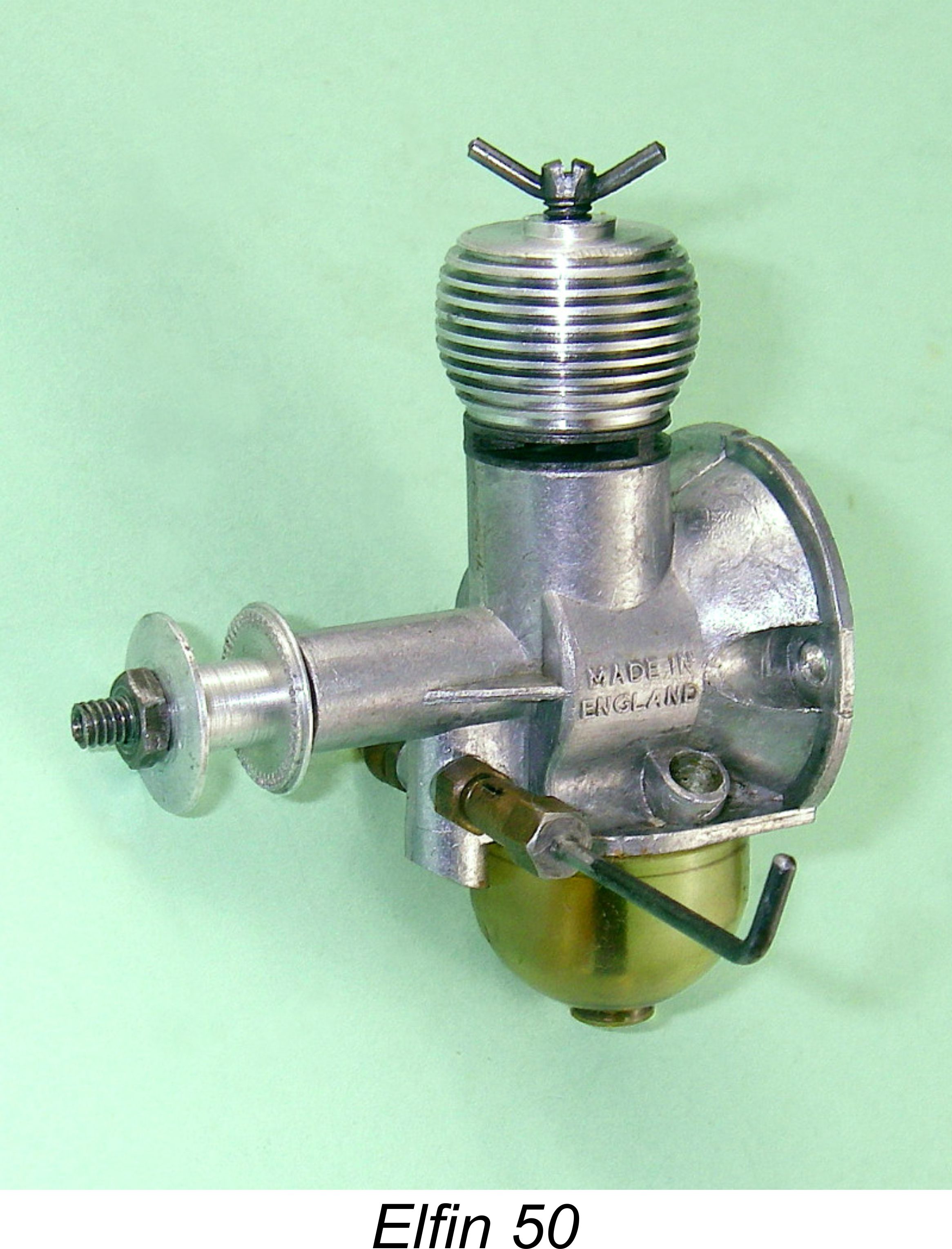 Here we share a look at the 0.54 cc Elfin 50, a very rare little British diesel from the early 1950’s which showed great promise in design terms but failed to make the grade in the marketplace for a variety of reasons. In consequence, it is undoubtedly the most elusive and little-known member of the British ½ cc diesel family of its era.
Here we share a look at the 0.54 cc Elfin 50, a very rare little British diesel from the early 1950’s which showed great promise in design terms but failed to make the grade in the marketplace for a variety of reasons. In consequence, it is undoubtedly the most elusive and little-known member of the British ½ cc diesel family of its era.
The Elfin 50 was the smallest-ever member of the Elfin family of model diesels produced by Aerol Engineering of Henry Street, Liverpool 13, England. The history of this company has been recorded in great detail in my earlier article covering the career of company founder Frank Ellis, which may still be accessed on the late Ron Chernich’s “Model Engine News” (MEN) web-site. Readers wishing to know more about the company’s early years are referred to that article. However, for convenience I'll summarize the main points here.
Background
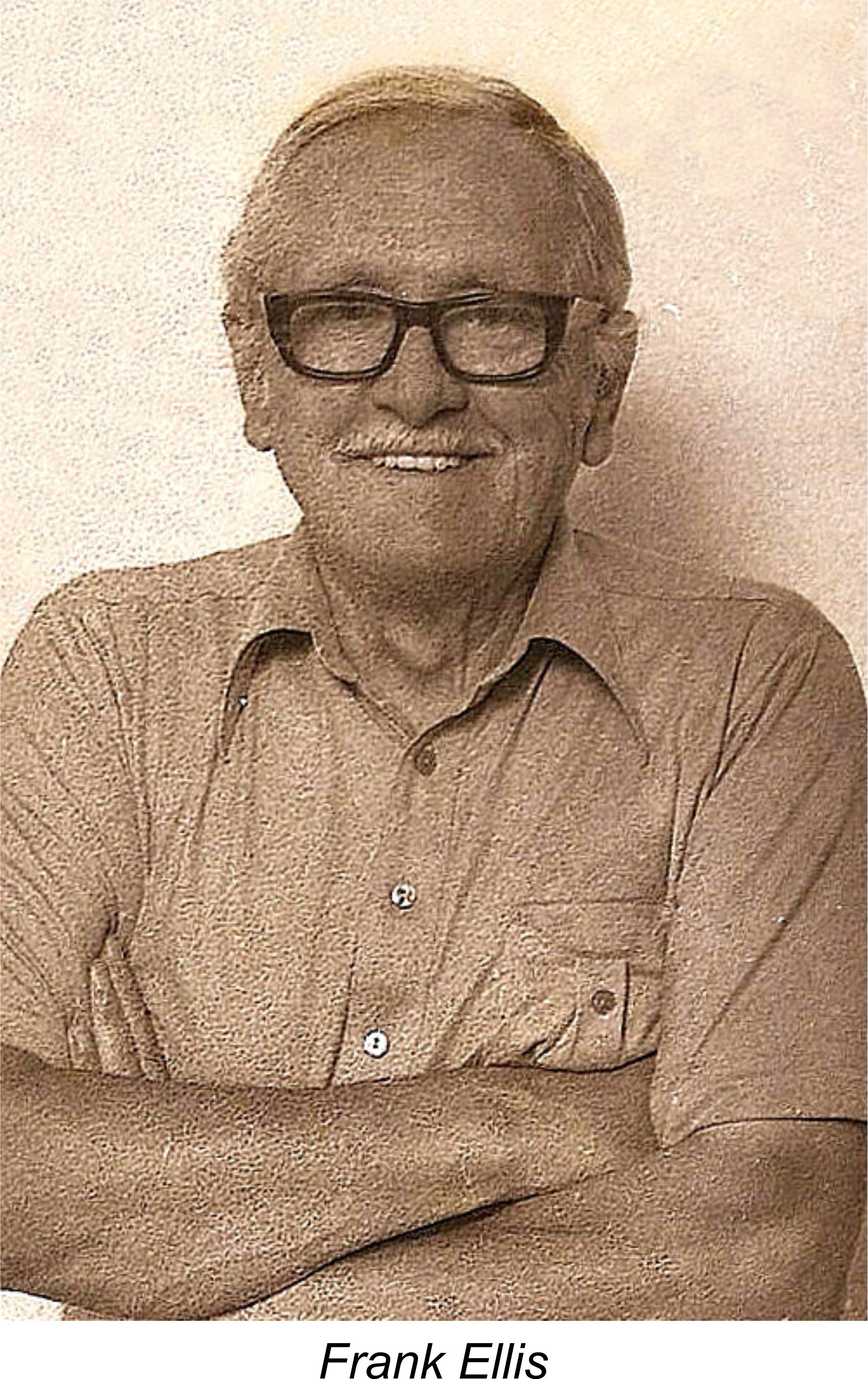 Aerol Engineering was established in late 1946 by a gentleman named Frank Ellis, with financial backing from Colonel Thomas E. H. Davies of the old-established Liverpool cotton brokerage firm of Davies, Benachie & Co. The Aerol company began life as an adjunct to a scrap metal business which Frank Ellis had previously established with a number of associates. The workshop was equipped with a small inventory of well-used machine tools which had given their best to the war effort before becoming surplus and hence cheaply available following the conclusion of hostilities. This well-worn equipment was originally housed in a lean-to metal shed in one corner of the scrapyard! Later an expanded brick-built factory was constructed on the same site.
Aerol Engineering was established in late 1946 by a gentleman named Frank Ellis, with financial backing from Colonel Thomas E. H. Davies of the old-established Liverpool cotton brokerage firm of Davies, Benachie & Co. The Aerol company began life as an adjunct to a scrap metal business which Frank Ellis had previously established with a number of associates. The workshop was equipped with a small inventory of well-used machine tools which had given their best to the war effort before becoming surplus and hence cheaply available following the conclusion of hostilities. This well-worn equipment was originally housed in a lean-to metal shed in one corner of the scrapyard! Later an expanded brick-built factory was constructed on the same site.
Using these undeniably basic facilities, production of model engines commenced in mid 1947 with the introduction of the 2 cc Aerol Gremlin diesel. This was soon followed by an updated model called the Aerol Hurricane. My earlier article about the Aerol engines may be found elsewhere on this website.
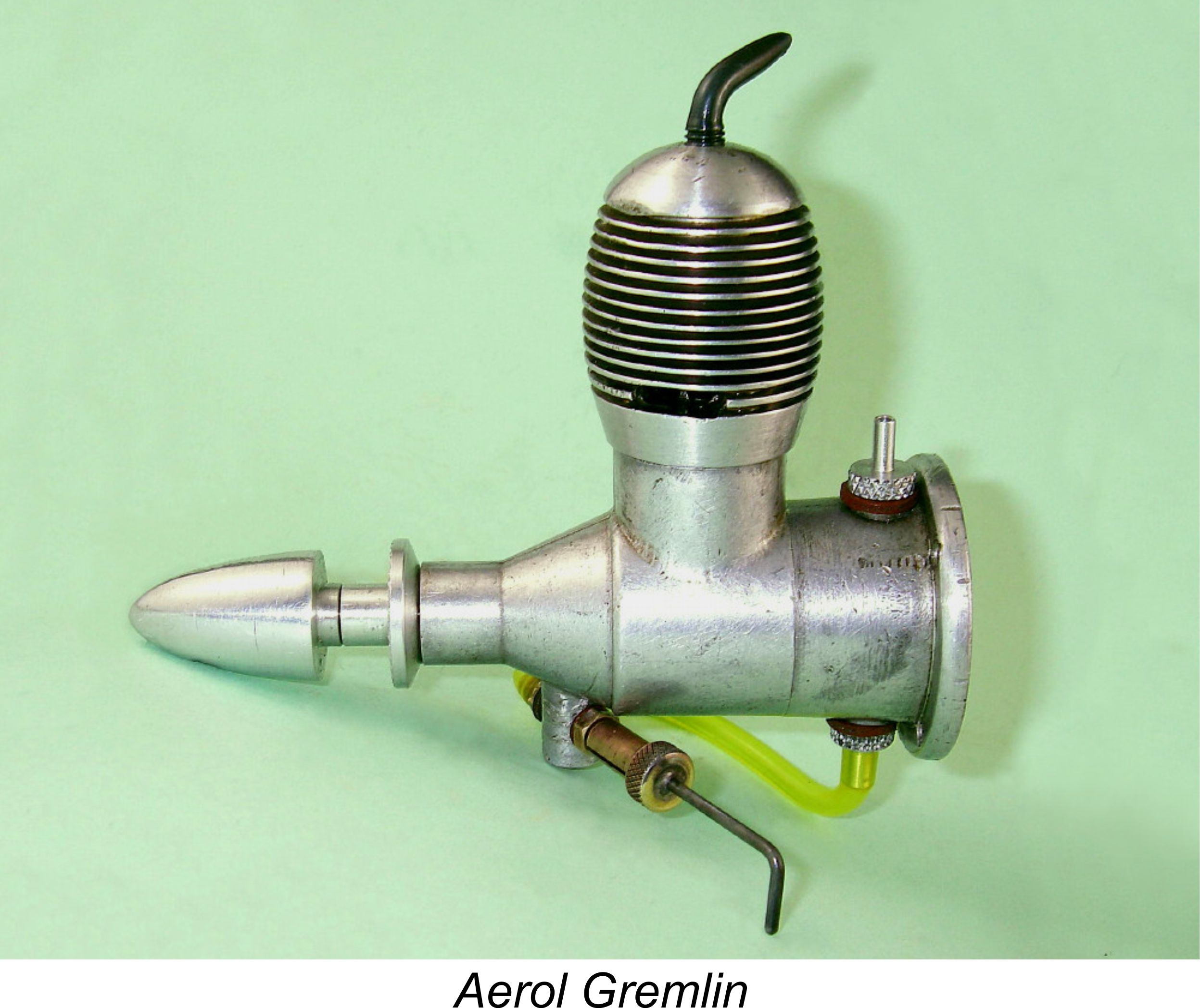 The Aerol series was supplanted in mid 1948 by the first of the Elfin range, the iconic 1.8 cc model. Although the domestic distribution of the Elfin range was quickly taken up first by Henry J. Nicholls and later by KeilKraft, Davies-Benachi acted from the outset as their overseas distributors, adding this portfolio to their ongoing cotton brokerage business.
The Aerol series was supplanted in mid 1948 by the first of the Elfin range, the iconic 1.8 cc model. Although the domestic distribution of the Elfin range was quickly taken up first by Henry J. Nicholls and later by KeilKraft, Davies-Benachi acted from the outset as their overseas distributors, adding this portfolio to their ongoing cotton brokerage business.
Many years later in around 1990, family friend Jim Woodside taped an interview with company founder Frank Ellis in which Frank (then some 85 years old) was very forthcoming about this and many other matters relating to the affairs of Aerol Engineering. We all owe Jim an immense debt of gratitude for his care in preserving this material and for his kindness in making it available for study. My summary of this fascinating interview may be found on MEN in the previously-noted Frank Ellis tribute page.
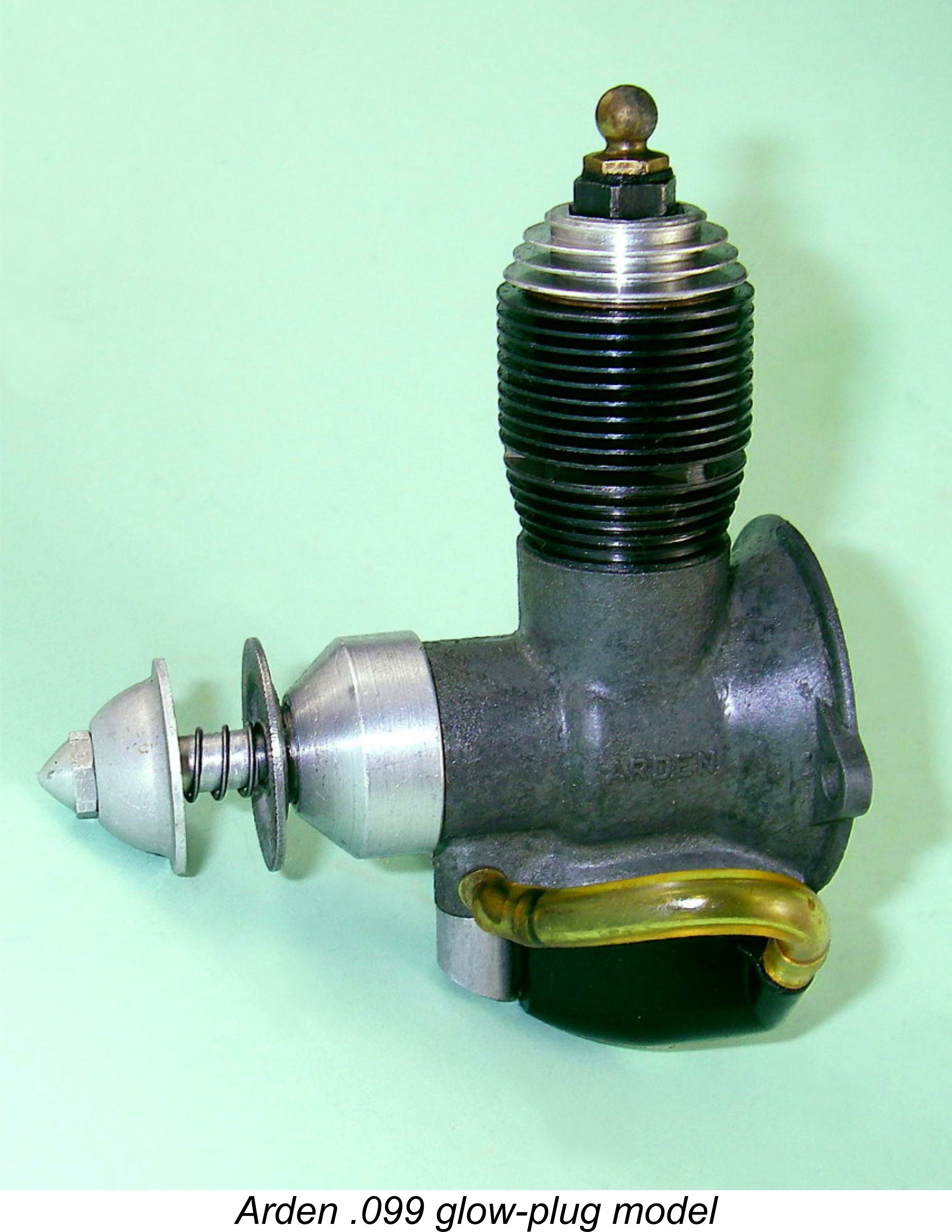 Frank recalled that he was very impressed with the general design of the radially-ported front rotary valve (FRV) Arden engines from America, seeing them as pointerstowards the future in contrast to the sideport engines which then dominated the British market. The Arden influence is very obvious in the design of the early Aerol engines and their 1948 Elfin successors with their radial mounting, 360 degree porting and updraft FRV induction. All of these early radial-mount units featured very sturdy gravity die-cast cases.
Frank recalled that he was very impressed with the general design of the radially-ported front rotary valve (FRV) Arden engines from America, seeing them as pointerstowards the future in contrast to the sideport engines which then dominated the British market. The Arden influence is very obvious in the design of the early Aerol engines and their 1948 Elfin successors with their radial mounting, 360 degree porting and updraft FRV induction. All of these early radial-mount units featured very sturdy gravity die-cast cases.
In 1950 designer Ellis abandoned the Arden-influenced radial-mount designs in favor of far more conventional beam-mounted engines having 1.49 cc and 2.49 cc displacements and featuring downdraft FRV induction along with pressure die-cast cases. Since the beam-mount 2.49 cc model did not equal the performance of its radial-mount predecessor, it has often been asked why the company made this change. In his later reminiscences, Frank stated that the sole reason for the switch was that rising demand for the engines was placing the company under pressure to make more of them. The revised pressure die-cast engines could be manufactured at a faster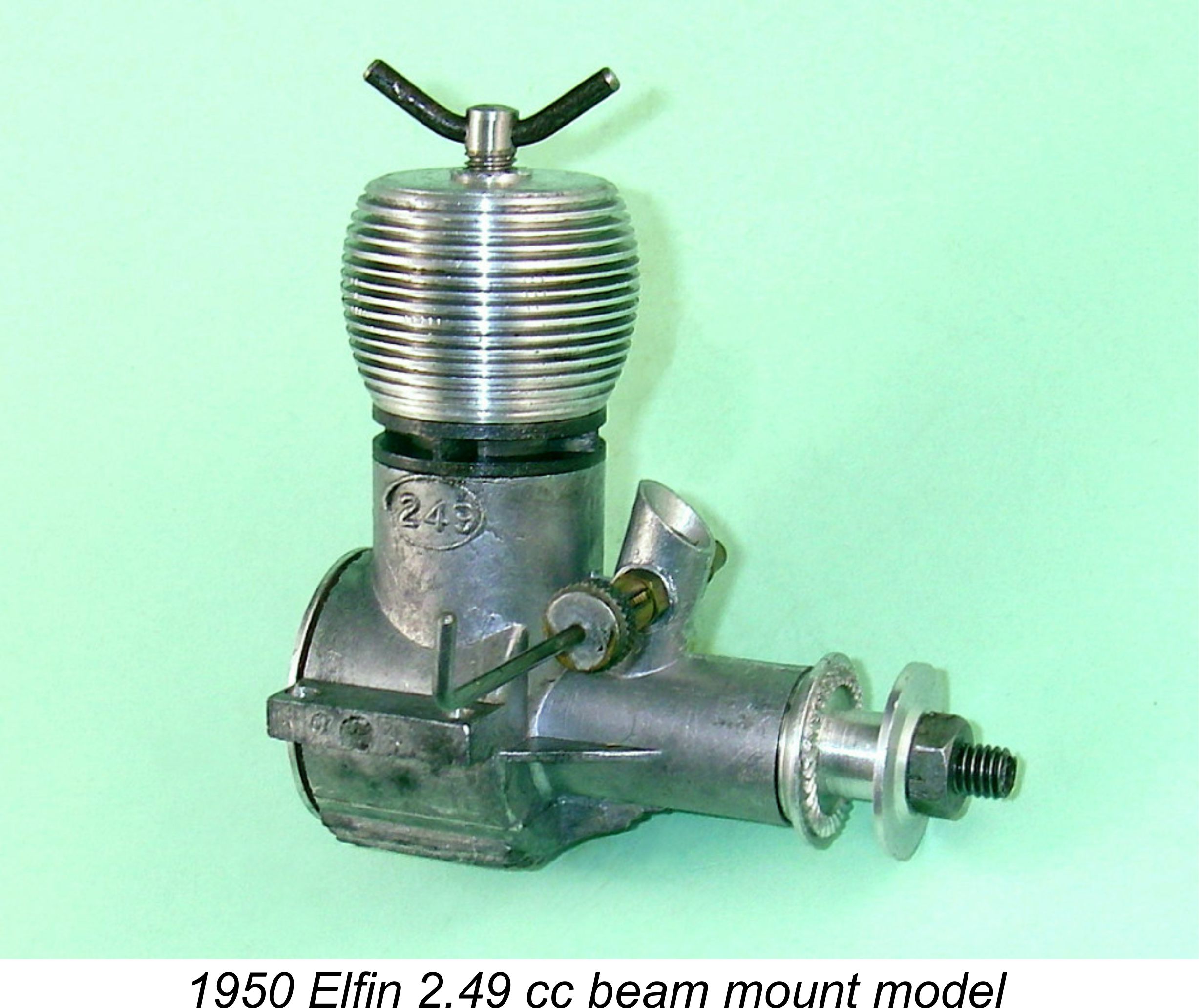 rate with the equipment available. However, the die-cast cases were less sturdy and far more prone to distortion than the earlier gravity die-cast components. In hindsight, Frank felt that they should have continued to develop their former designs, even if it meant accepting lower production rates.
rate with the equipment available. However, the die-cast cases were less sturdy and far more prone to distortion than the earlier gravity die-cast components. In hindsight, Frank felt that they should have continued to develop their former designs, even if it meant accepting lower production rates.
The plain bearing beam mount Elfin  1.49 cc diesel was a huge success, becoming the most popular Elfin model of them all. It remained in production for some 7 years, achieving an enviable record of stellar competition successes along the way. These triumphs included first place in the 1952 World Free Flight Championship as well as a very creditable fourth place in the same event in 1954. The main Achilles Heel of the 1.49 was a decided variability in quality, doubtless arising from the enforced ongoing use of well-worn production equipment. A good one was really good, but not all of them came up to that standard ......
1.49 cc diesel was a huge success, becoming the most popular Elfin model of them all. It remained in production for some 7 years, achieving an enviable record of stellar competition successes along the way. These triumphs included first place in the 1952 World Free Flight Championship as well as a very creditable fourth place in the same event in 1954. The main Achilles Heel of the 1.49 was a decided variability in quality, doubtless arising from the enforced ongoing use of well-worn production equipment. A good one was really good, but not all of them came up to that standard ......
Despite the 1950 switch to the more conventional beam-mount designs, Frank Ellis had lost none of his admiration for the Arden layout. Moreover, circumstances were unfolding which would give him one more opportunity to express himself in that direction. In October 1950 a really significant event occurred in the context of the British model engine manufacturing industry - Alan Allbon introduced 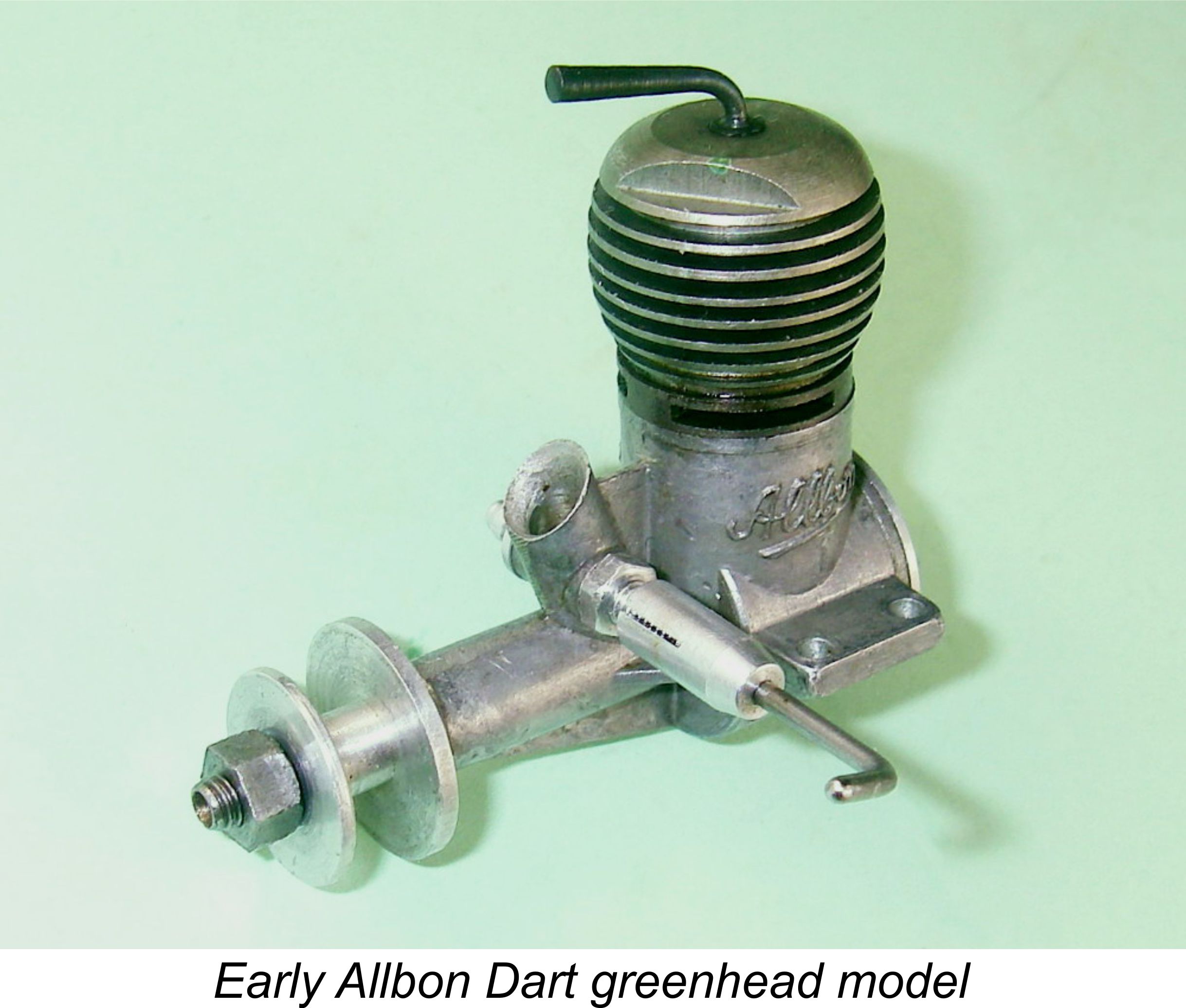 his trend-setting 0.55 cc Dart model, thus setting a fashion for ½ cc diesels in England. International Model Aircraft soon joined in the fun with their 0.5 cc FROG 50 model, while E.D. too were not far behind with their 0.46 cc Baby.
his trend-setting 0.55 cc Dart model, thus setting a fashion for ½ cc diesels in England. International Model Aircraft soon joined in the fun with their 0.5 cc FROG 50 model, while E.D. too were not far behind with their 0.46 cc Baby.
Frank Ellis took note of the very positive reception accorded to the Dart and decided at once that if the next British modelling fad was going to be ½ cc diesels, he was not going to be left out! He elected to enter this field himself with a new model which would prove to be his most openly Arden-influenced design of them all - the Elfin 50 which forms our main subject.
Description
The Elfin 50 was announced shortly after the appearance of the Dart, although its actual entry into the marketplace was delayed until January 1952, likely as a result of production difficulties, of which more anon. When it finally appeared, there could be no denying the fact that to all intents and purposes it was a reduced-scale diesel version of the famous Arden spark-ignition and glow-plug engines. It featured an identical conical radial mount with screw-in backplate, 360-degree porting, updraft FRV induction and an under-slung plastic tank, all derived directly from the Arden layout. The only major departures in fact were the use of compression ignition coupled with a plain bearing instead of the Arden’s twin ball races.
 Frank Ellis clearly favoured under-square engines, and the new 50 maintained that trend. The measured bore and stroke of the illustrated example are 8.36mm x 9.78mm, giving a calculated displacement of 0.54 cc, a little above the nominal displacement, just like the similar-sized 0.55 cc Allbon Dart. This displacement was later repeated in Alan Allbon’s excellent little A-S 55 of late 1959.
Frank Ellis clearly favoured under-square engines, and the new 50 maintained that trend. The measured bore and stroke of the illustrated example are 8.36mm x 9.78mm, giving a calculated displacement of 0.54 cc, a little above the nominal displacement, just like the similar-sized 0.55 cc Allbon Dart. This displacement was later repeated in Alan Allbon’s excellent little A-S 55 of late 1959.
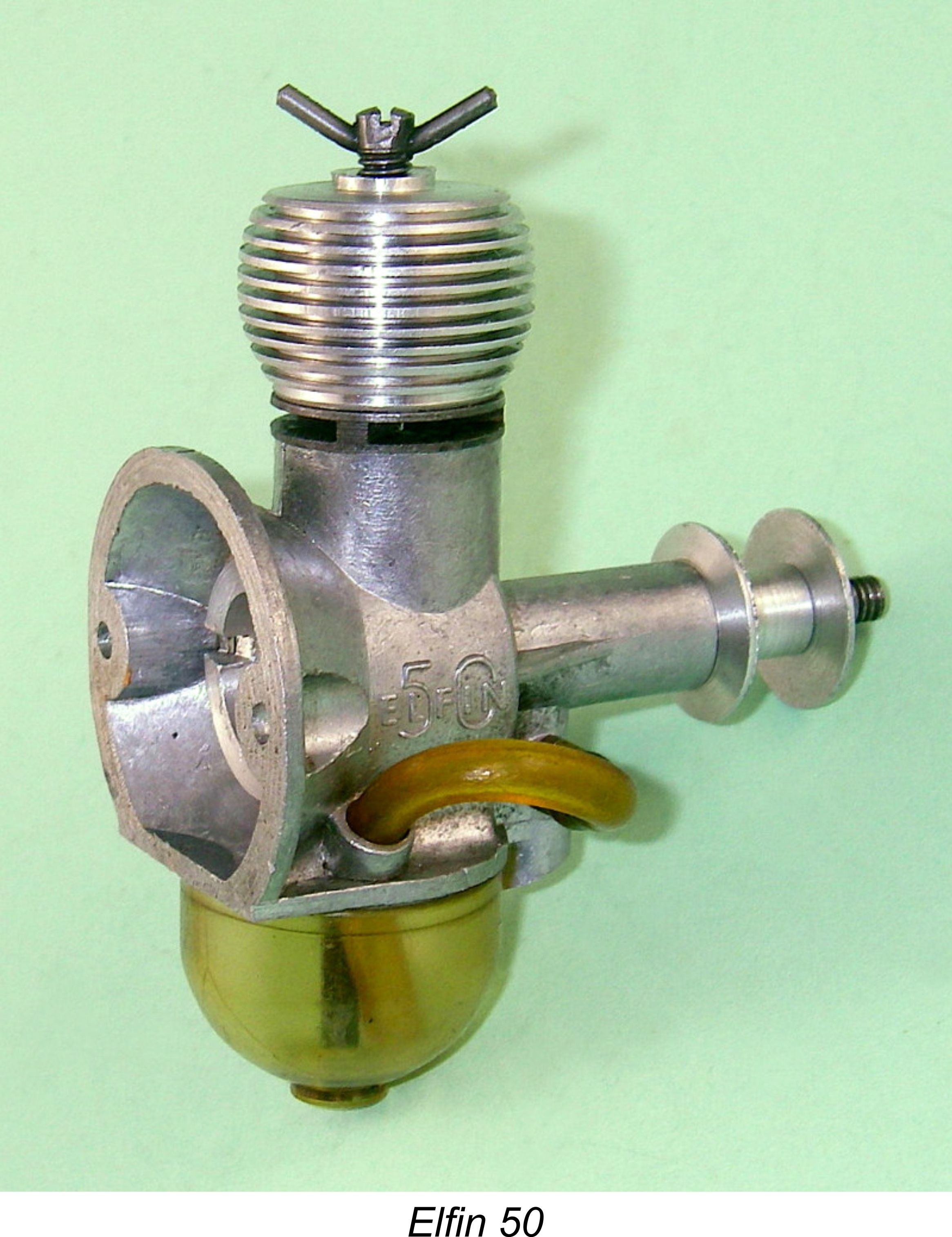 Apart from the Arden-inspired features described above, the Elfin 50 was essentially a completely conventional radially-ported plain bearing FRV diesel of its day. As such, a detailed technical description does not appear warranted here. Although it was basically a very compact little engine, its bulk was considerably increased by the presence of the under-slung tank and radial backplate mount. Even with these features, checked weight all complete as illustrated without prop was only 1.5 ounces (42 gm).
Apart from the Arden-inspired features described above, the Elfin 50 was essentially a completely conventional radially-ported plain bearing FRV diesel of its day. As such, a detailed technical description does not appear warranted here. Although it was basically a very compact little engine, its bulk was considerably increased by the presence of the under-slung tank and radial backplate mount. Even with these features, checked weight all complete as illustrated without prop was only 1.5 ounces (42 gm).
As supplied, the engine was clearly best adapted to free flight use - the standard tank would have been useless in a control line application. This may in fact have worked against it in terms of its marketplace acceptance. However, other factors appear to have contributed far more to its downfall, as we shall see in the following section.
Production History
The Elfin 50 was initially promoted quite vigorously, with advertisements appearing in “Aeromodeller” magazine more or less continuously from January 1952 to August 1952, after which it quietly disappeared from the market. It has always been assumed from this that the engine was not a success in the marketplace and was withdrawn for that reason. In fact, the real reason for the engine’s disappearance was far more complex.........
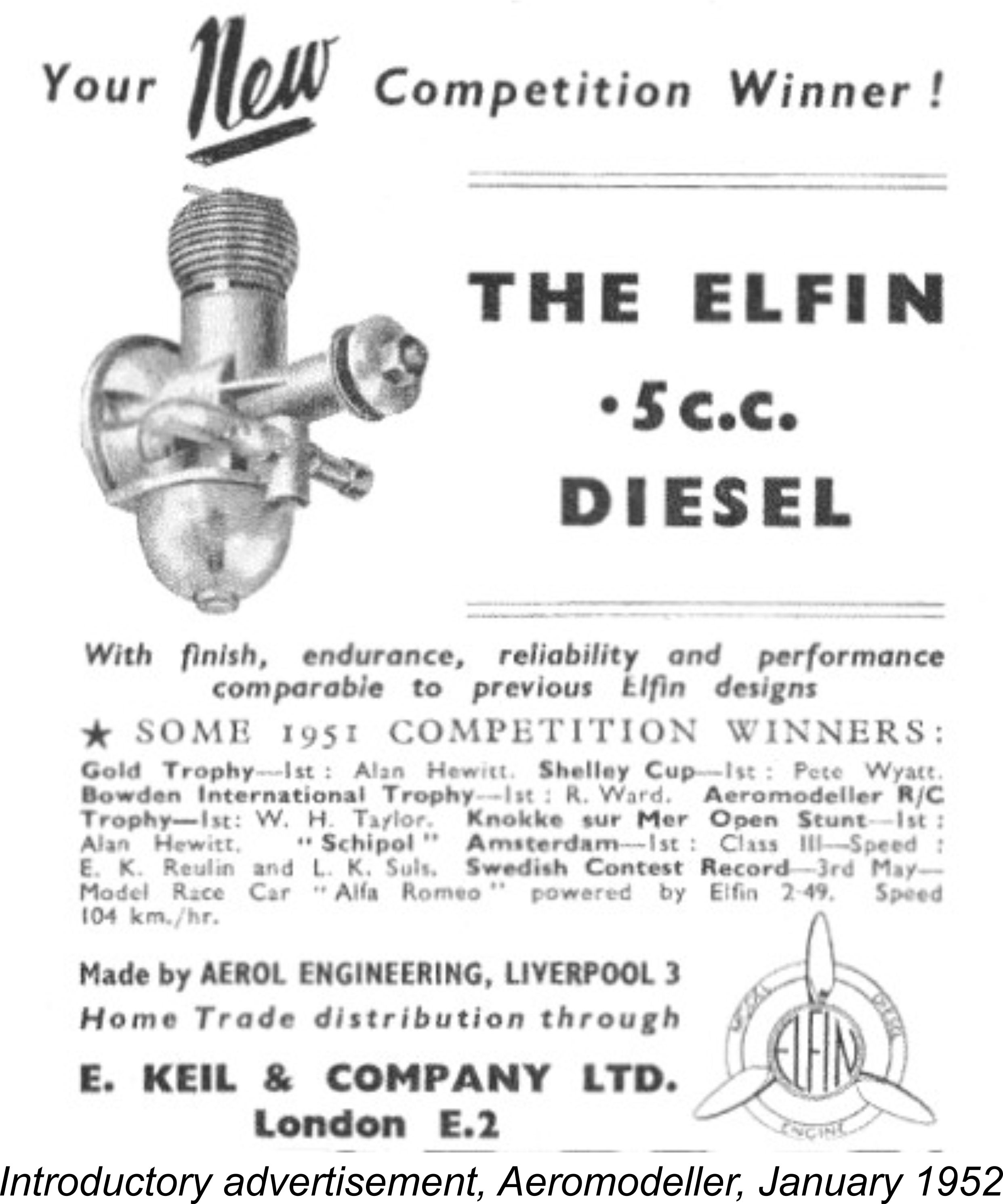 In the above-mentioned recorded interview with Jim Woodside, Frank Ellis discussed this very point in some detail. As stated earlier, the machinery used to make the engines was well-used wartime surplus equipment which had given its best to the war effort, consequently having been obtained cheaply when Aerol Engineering started up in late 1946. Basically, it was knackered to begin with, and by early 1952 it was well past it, having put in a further 5 years of hard grind making Aerol and Elfin engines. This explains the fact that the Elfin engines were well known to be a bit spotty from a quality standpoint, although if you got a good one, it was really good. The designs were excellent - it was inconsistency of production standards that let them down.
In the above-mentioned recorded interview with Jim Woodside, Frank Ellis discussed this very point in some detail. As stated earlier, the machinery used to make the engines was well-used wartime surplus equipment which had given its best to the war effort, consequently having been obtained cheaply when Aerol Engineering started up in late 1946. Basically, it was knackered to begin with, and by early 1952 it was well past it, having put in a further 5 years of hard grind making Aerol and Elfin engines. This explains the fact that the Elfin engines were well known to be a bit spotty from a quality standpoint, although if you got a good one, it was really good. The designs were excellent - it was inconsistency of production standards that let them down.
Frank recalled that initial tests on the Elfin 50 prototypes were extremely encouraging, showing that the little beastie could run with the best of them! Present-day experience bears this out completely - the engine is more than a match for any of its 1952 British half-cc competitors, including the Dart. But the problem was that like all small engines, the little 50 required an even higher degree of manufacturing precision than its larger relatives. And therein lay the problem! Despite intensive efforts, it proved impossible to manufacture this little engine in quantity using the tired equipment which was all that was available. An unacceptably high proportion of the completed engines proved to have manufacturing defects which precluded their being offered for sale. Frank recalled that even some of the ones which were released to the trade by Aerol Engineering were returned as un-saleable.
The company had invested quite heavily in the new model - according to Frank, each new set of dies (which were 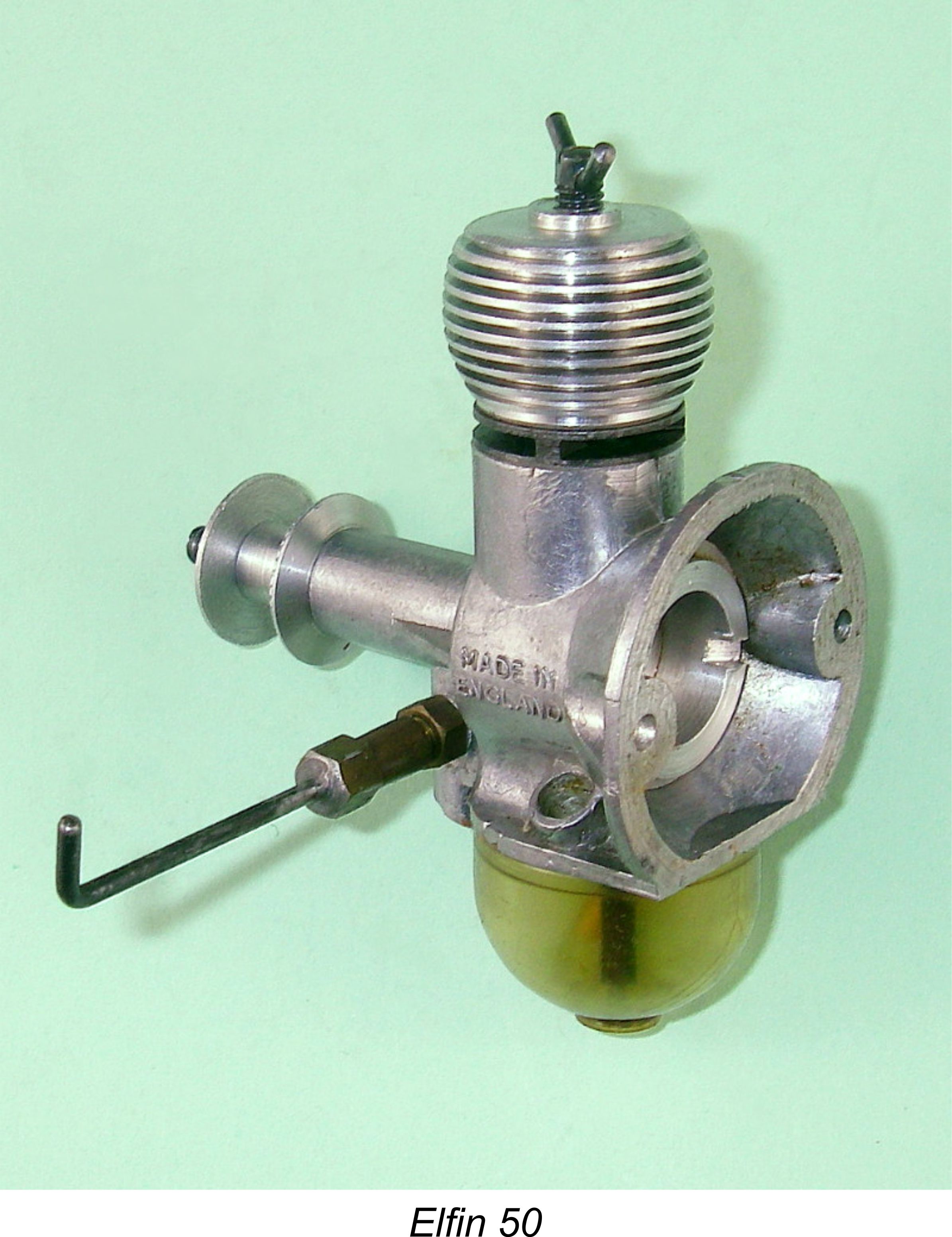 produced by the same Blackpool firm which did the castings) cost them around £500 (a chunk of change in 1952) before they saw a single casting! On top of this, the fact that they could only sell a proportion of the engines that they did make, coupled with the need to maintain a more-or-less competitive price (£3 7s 6d, or £3.37 in modern terms), meant that they were actually losing money making this model. In addition, their reputation was under threat.
produced by the same Blackpool firm which did the castings) cost them around £500 (a chunk of change in 1952) before they saw a single casting! On top of this, the fact that they could only sell a proportion of the engines that they did make, coupled with the need to maintain a more-or-less competitive price (£3 7s 6d, or £3.37 in modern terms), meant that they were actually losing money making this model. In addition, their reputation was under threat.
It was clear that if the 50 was to remain in production, the company would have to invest in new machine tooling. However, they were still in debt for their expanded factory and existing equipment, hence being unable to finance the required new machinery themselves. Accordingly, they approached their original backer Colonel Davies once again. Davies-Benachi had continued throughout to handle the overseas distribution of the Elfin range, and Colonel Davies remained very well-disposed towards them. He readily agreed to back the financing of new equipment, which was duly ordered. Problem solved, it seemed!
However, in one of those cruel twists of fate by which future events can be so greatly influenced, Colonel Davies unexpectedly died on May 5th, 1952 - the very day on which the new machinery arrived at Henry Street! Having lost their financial guarantor, the company had no recourse other than to send it straight back on the same truck. Frank’s quote from his 1990 interview with Jim Woodside: “If Colonel Davies hadn’t died when he did, that business (Aerol Engineering) would still be going today!”
After this set-back, Frank decided that Aerol Engineering had no choice other than to cut their losses by ending production of the Elfin 50. This action was taken with extreme reluctance, since Frank sincerely believed in the merits of the design. However, he felt that there was no option, the consequence being that the engine suffered a premature demise, never coming close to repaying its development costs. We might re-phrase the earlier quote from Frank by saying that if Colonel Davies hadn’t died when he did, there would be far more surviving original examples of the Elfin 50 today!
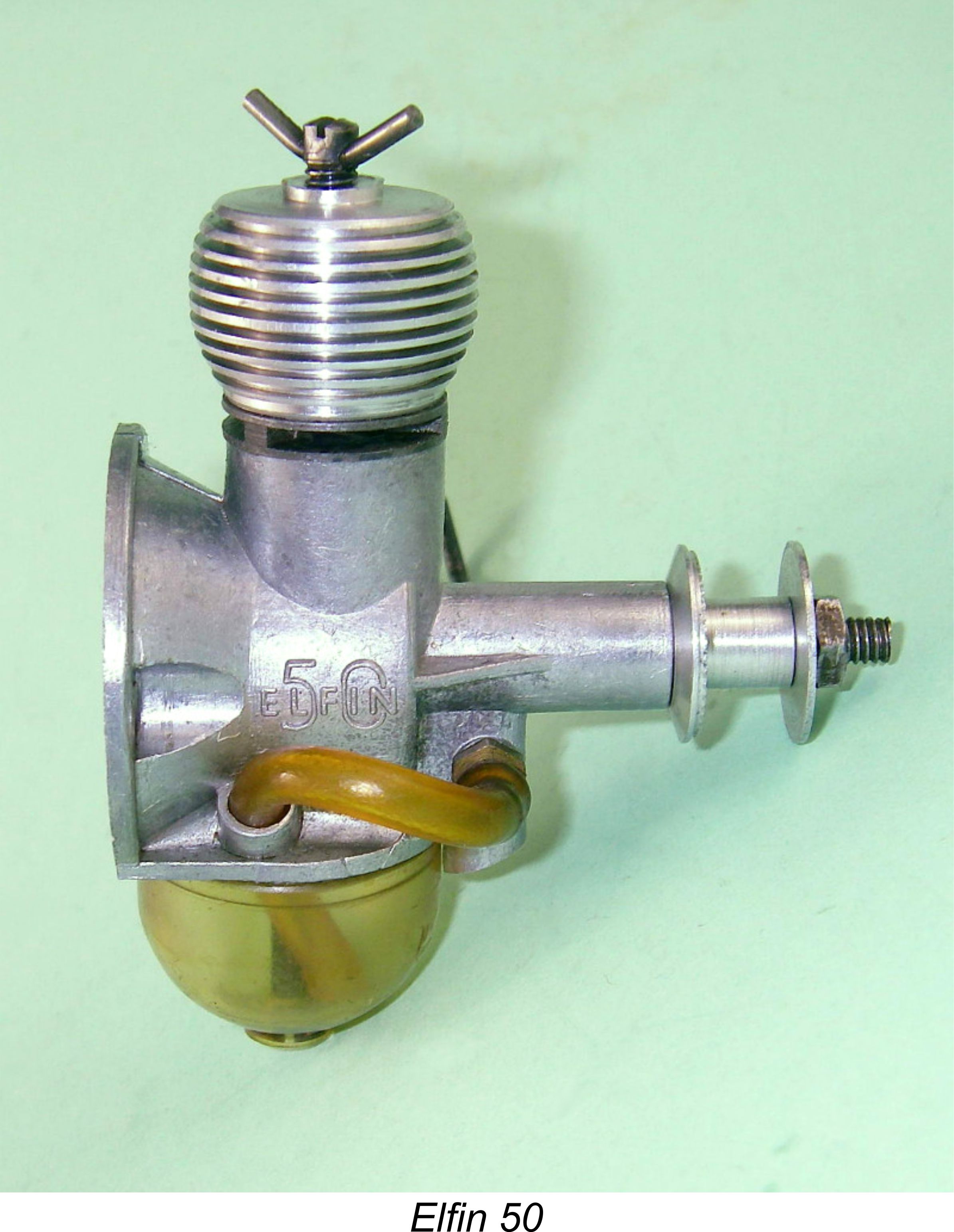 Years later, at the time of his 1990 interview with Jim Woodside, Frank still held to the sincere belief that the Elfin 50 would have been a great success if they could have kept making it. He stated that the good ones that did get shipped found ready buyers and that market resistance was not a factor in his decision. As far as he could recall, the company only ended up selling a few hundred examples of the Elfin 50, which explains why it’s such a highly prized and high-priced item among today’s collectors.
Years later, at the time of his 1990 interview with Jim Woodside, Frank still held to the sincere belief that the Elfin 50 would have been a great success if they could have kept making it. He stated that the good ones that did get shipped found ready buyers and that market resistance was not a factor in his decision. As far as he could recall, the company only ended up selling a few hundred examples of the Elfin 50, which explains why it’s such a highly prized and high-priced item among today’s collectors.
Looking at this matter objectively with the benefit of hindsight, it actually appears to me to be quite probable that the engine would eventually have encountered a fair degree of sales resistance, Frank’s views notwithstanding. The more or less simultaneous entry of four British manufacturers into the ½ cc diesel field quickly resulted in an over-saturated buyers' market in which only the best could hope to survive. In performance terms, the Elfin was indeed up there with the best, but this was by no means the only factor affecting the engine’s sales potential.
For one thing, the British marketplace had by then come down firmly in favor of beam mounting as the preferred installation arrangement. Moreover, the general layout with the under-slung tank forced the engine to be mounted in an upright position if the supplied tank was to be used. This would be OK for free flight, although the lack of a timer would have forced the use of the very basic and extremely imprecise “watch the level in the tank” method of flight timing. In addition, the engine’s relative bulk by comparison with its direct competitors as well as its radial mounting and inconvenient layout for mounting positions other than upright would likely have resulted in a progressive erosion of its position in the ½ cc marketplace unless modifications were made. However, other factors supervened before this could be put to the test.
The Elfin 50’s tenure in the marketplace was so short that the engine was never the subject of a published test in the contemporary modelling media. I haven’t run my own example for some years now, but my notes record that it was pretty much comparable to the category-leading Allbon Dart in the performance department, with if anything a slight edge in torque production at the lower speeds. I may get around to a re-test at some point, in which case I will append the test results to this article if the opportunity still exists to do so.
Conclusion
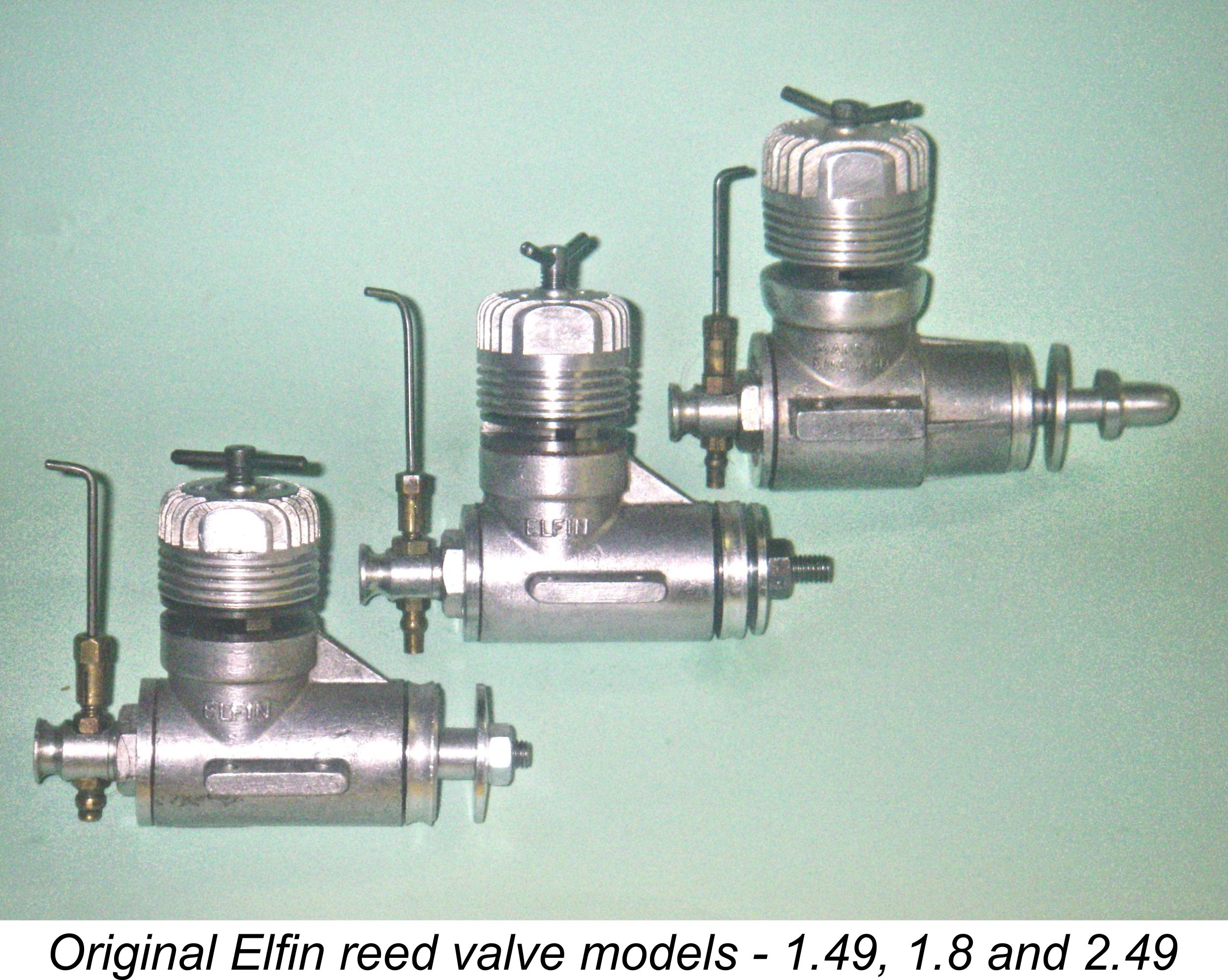 The Elfin range continued for a further 5 years, the highlight being the appearance of the Elfin twin ball race reed valve models beginning in October 1954. However, the equipment issue continued to plague the company as the already-tired equipment became even more worn, with the resulting quality control issues leading to progressively increasing customer dissatisfaction. As of early 1957 the company gave up the struggle - their final advertisement appeared in the January 1957 issue of “Aeromodeller”. According to Frank Ellis, they were still in debt to their various creditors, hence being forced to sell everything to get clear without declaring bankruptcy. The range was picked up briefly by Auto-Vaporisers Ltd. of Lymm, Cheshire, but they too threw in the towel in mid 1958 without ever re-introducing the Elfin 50.
The Elfin range continued for a further 5 years, the highlight being the appearance of the Elfin twin ball race reed valve models beginning in October 1954. However, the equipment issue continued to plague the company as the already-tired equipment became even more worn, with the resulting quality control issues leading to progressively increasing customer dissatisfaction. As of early 1957 the company gave up the struggle - their final advertisement appeared in the January 1957 issue of “Aeromodeller”. According to Frank Ellis, they were still in debt to their various creditors, hence being forced to sell everything to get clear without declaring bankruptcy. The range was picked up briefly by Auto-Vaporisers Ltd. of Lymm, Cheshire, but they too threw in the towel in mid 1958 without ever re-introducing the Elfin 50.
Due to the very low production which was actually achieved, the Elfin 50 is extremely rare today, especially in complete and original condition. Finding a good example is pretty much a matter of being in the right place at the right time with the right amount of purchasing power, a position in which I was fortunate enough to find myself on just one occasion in the dim and distant past.
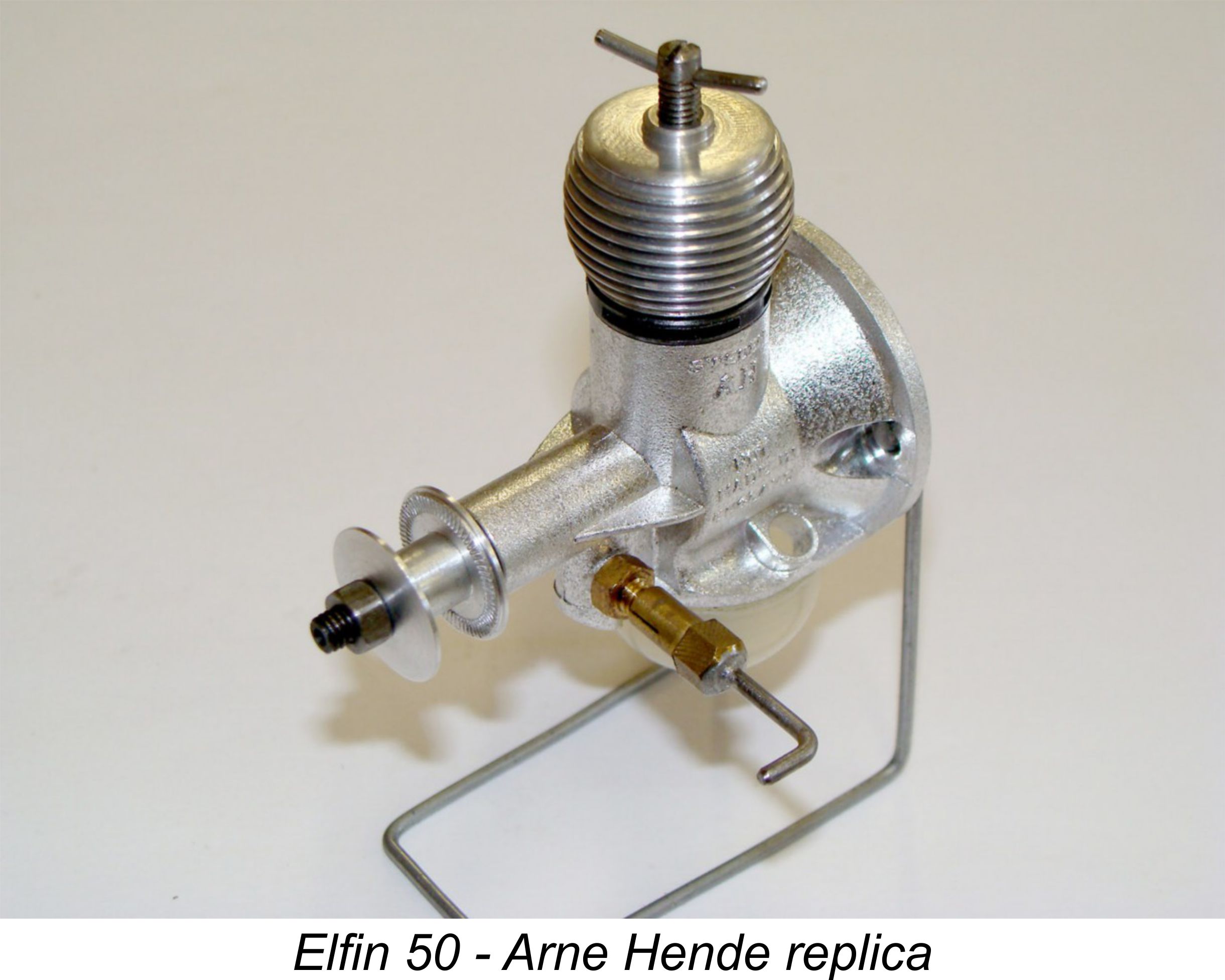 As the model engine collecting movement gained momentum in the 1980’s and 1990’s, the scarcity of original examples opened up a market niche for replica productions of the engine. The noted Swedish enthusiast Arne Hende took up this challenge, arranging for the manufacture of a series of very faithful replicas of the Elfin 50 many years after the withdrawal from production of the original. Arne’s engines were made to a very high standard, hence being fine collectibles in their own right. There’s actually a better chance of finding one of his Elfin 50’s in mint condition than there is of finding a complete and original Aerol example.
As the model engine collecting movement gained momentum in the 1980’s and 1990’s, the scarcity of original examples opened up a market niche for replica productions of the engine. The noted Swedish enthusiast Arne Hende took up this challenge, arranging for the manufacture of a series of very faithful replicas of the Elfin 50 many years after the withdrawal from production of the original. Arne’s engines were made to a very high standard, hence being fine collectibles in their own right. There’s actually a better chance of finding one of his Elfin 50’s in mint condition than there is of finding a complete and original Aerol example.
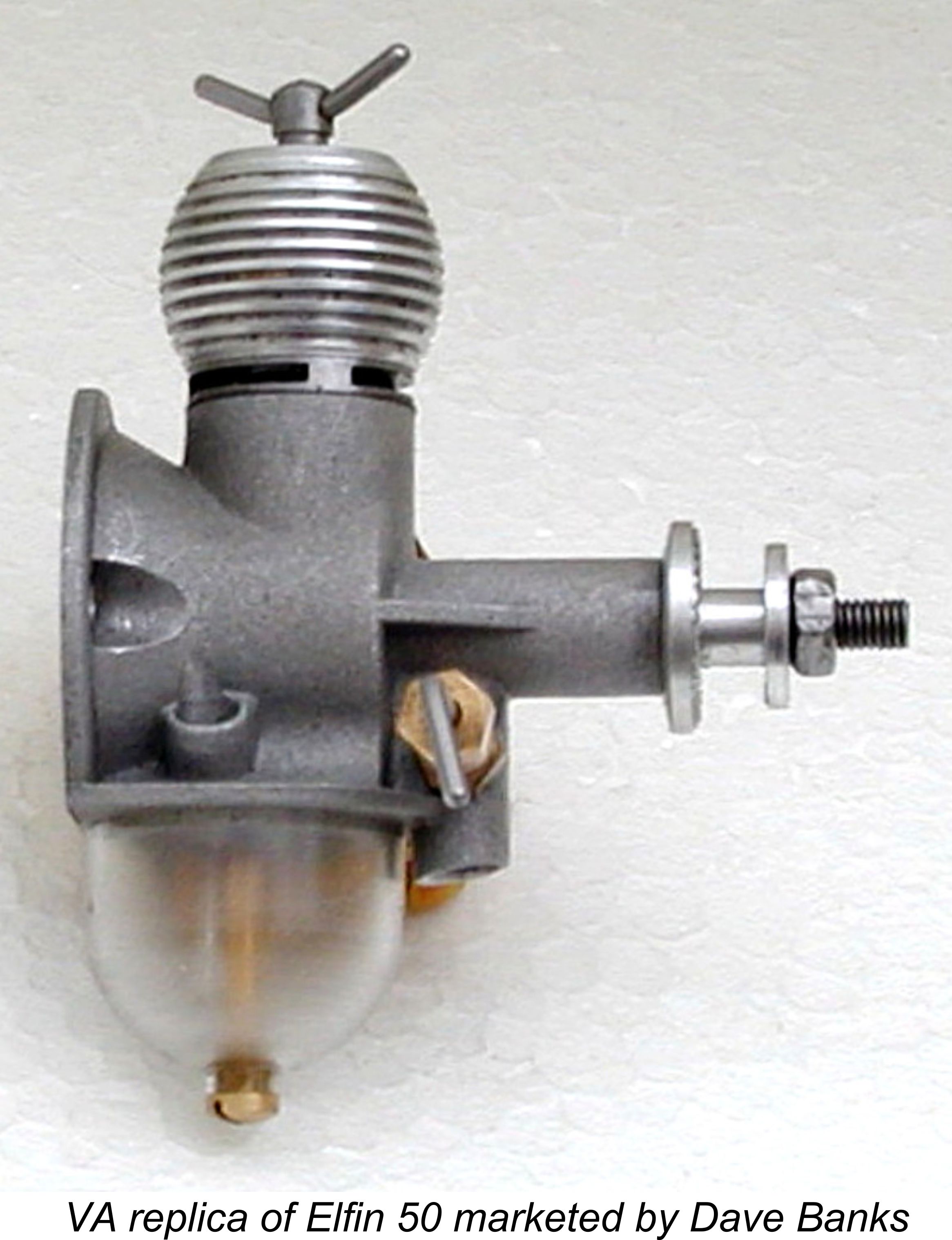 Another Elfin 50 “replica” was manufactured in small numbers in St. Petersburg, Russia by a fellow named Valentin Aloshkin, whose products were generally known as VA engines. The engines manufactured by Aloshkin included a number of classic diesel replicas such as the Elfin 50, the Elfin 1.8, the E.D. Bee, the E.D Baby, the Mills .75, the Kalper .32 and the Micro Diesel from America. There were also a few modern high-performance .049 glow-plug models. These engines were marketed in the West by Dave Banks of England.
Another Elfin 50 “replica” was manufactured in small numbers in St. Petersburg, Russia by a fellow named Valentin Aloshkin, whose products were generally known as VA engines. The engines manufactured by Aloshkin included a number of classic diesel replicas such as the Elfin 50, the Elfin 1.8, the E.D. Bee, the E.D Baby, the Mills .75, the Kalper .32 and the Micro Diesel from America. There were also a few modern high-performance .049 glow-plug models. These engines were marketed in the West by Dave Banks of England.
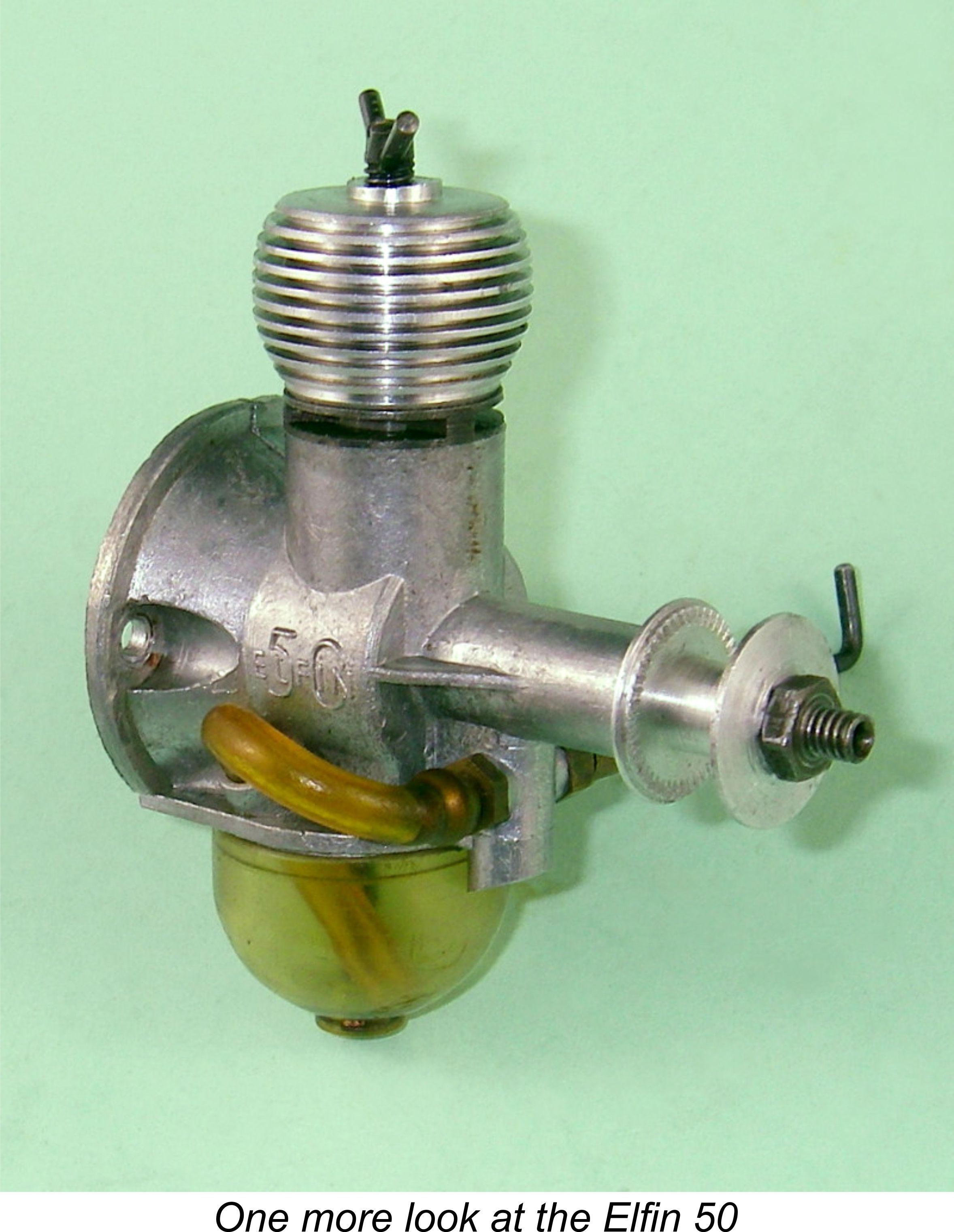 The VA mini-replica Elfin 50 had a displacement of 0.25 cc. The engines were all manufactured to very high standards. I've never run my own New In Box example which was kindly provided to me by my friend and colleague Jim Woodside. However, Jim tells me that he retains several examples of this model and that they run very well.
The VA mini-replica Elfin 50 had a displacement of 0.25 cc. The engines were all manufactured to very high standards. I've never run my own New In Box example which was kindly provided to me by my friend and colleague Jim Woodside. However, Jim tells me that he retains several examples of this model and that they run very well.
Quite apart from their physical size, the VA "Elfins" are easily distinguishable from the originals due to the vapor-blasted finish used on their castings. Hence they are not really true replicas. However, like the Hende versions they are fine collectibles in their own right.
The relatively few surviving complete and original examples of the Elfin 50 stand today as a testament to the enthusiasm of Frank Ellis and his unstinting admiration for the designs of the great Ray Arden. Anyone who is in a position to enjoy owning one of these fascinating and highly individualistic little units may indeed count himself fortunate!!
___________________________________
Article © Adrian C. Duncan, Coquitlam, British Columbia, Canada
First published December 2014

 Here we share a look at the 0.54 cc Elfin 50, a very rare little British diesel from the early 1950’s which showed great promise in design terms but failed to make the grade in the marketplace for a variety of reasons. In consequence, it is undoubtedly the most elusive and little-known member of the British ½ cc diesel family of its era.
Here we share a look at the 0.54 cc Elfin 50, a very rare little British diesel from the early 1950’s which showed great promise in design terms but failed to make the grade in the marketplace for a variety of reasons. In consequence, it is undoubtedly the most elusive and little-known member of the British ½ cc diesel family of its era.  Aerol Engineering was established in late 1946 by a gentleman named Frank Ellis, with financial backing from Colonel Thomas E. H. Davies of the old-established Liverpool cotton brokerage firm of Davies, Benachie & Co. The Aerol company began life as an adjunct to a scrap metal business which Frank Ellis had previously established with a number of associates. The workshop was equipped with a small inventory of well-used machine tools which had given their best to the war effort before becoming surplus and hence cheaply available following the conclusion of hostilities. This well-worn equipment was originally housed in a lean-to metal shed in one corner of the scrapyard! Later an expanded brick-built factory was constructed on the same site.
Aerol Engineering was established in late 1946 by a gentleman named Frank Ellis, with financial backing from Colonel Thomas E. H. Davies of the old-established Liverpool cotton brokerage firm of Davies, Benachie & Co. The Aerol company began life as an adjunct to a scrap metal business which Frank Ellis had previously established with a number of associates. The workshop was equipped with a small inventory of well-used machine tools which had given their best to the war effort before becoming surplus and hence cheaply available following the conclusion of hostilities. This well-worn equipment was originally housed in a lean-to metal shed in one corner of the scrapyard! Later an expanded brick-built factory was constructed on the same site. The Aerol series was supplanted in mid 1948 by the first of the Elfin range, the iconic 1.8 cc model. Although the domestic distribution of the Elfin range was quickly taken up first by Henry J. Nicholls and later by KeilKraft, Davies-Benachi acted from the outset as their overseas distributors, adding this portfolio to their ongoing cotton brokerage business.
The Aerol series was supplanted in mid 1948 by the first of the Elfin range, the iconic 1.8 cc model. Although the domestic distribution of the Elfin range was quickly taken up first by Henry J. Nicholls and later by KeilKraft, Davies-Benachi acted from the outset as their overseas distributors, adding this portfolio to their ongoing cotton brokerage business.
 rate with the equipment available. However, the die-cast cases were less sturdy and far more prone to distortion than the earlier gravity die-cast components. In hindsight, Frank felt that they should have continued to develop their former designs, even if it meant accepting lower production rates.
rate with the equipment available. However, the die-cast cases were less sturdy and far more prone to distortion than the earlier gravity die-cast components. In hindsight, Frank felt that they should have continued to develop their former designs, even if it meant accepting lower production rates.
 his trend-setting 0.55 cc Dart model, thus setting a fashion for ½ cc diesels in England.
his trend-setting 0.55 cc Dart model, thus setting a fashion for ½ cc diesels in England. 
 Apart from the Arden-inspired features described above, the Elfin 50 was essentially a completely conventional radially-ported plain bearing FRV diesel of its day. As such, a detailed technical description does not appear warranted here. Although it was basically a very compact little engine, its bulk was considerably increased by the presence of the under-slung tank and radial backplate mount. Even with these features, checked weight all complete as illustrated without prop was only 1.5 ounces (42 gm).
Apart from the Arden-inspired features described above, the Elfin 50 was essentially a completely conventional radially-ported plain bearing FRV diesel of its day. As such, a detailed technical description does not appear warranted here. Although it was basically a very compact little engine, its bulk was considerably increased by the presence of the under-slung tank and radial backplate mount. Even with these features, checked weight all complete as illustrated without prop was only 1.5 ounces (42 gm). In the above-mentioned recorded interview with Jim Woodside, Frank Ellis discussed this very point in some detail. As stated earlier, the machinery used to make the engines was well-used wartime surplus equipment which had given its best to the war effort, consequently having been obtained cheaply when Aerol Engineering started up in late 1946. Basically, it was knackered to begin with, and by early 1952 it was well past it, having put in a further 5 years of hard grind making Aerol and Elfin engines. This explains the fact that the Elfin engines were well known to be a bit spotty from a quality standpoint, although if you got a good one, it was really good. The designs were excellent - it was inconsistency of production standards that let them down.
In the above-mentioned recorded interview with Jim Woodside, Frank Ellis discussed this very point in some detail. As stated earlier, the machinery used to make the engines was well-used wartime surplus equipment which had given its best to the war effort, consequently having been obtained cheaply when Aerol Engineering started up in late 1946. Basically, it was knackered to begin with, and by early 1952 it was well past it, having put in a further 5 years of hard grind making Aerol and Elfin engines. This explains the fact that the Elfin engines were well known to be a bit spotty from a quality standpoint, although if you got a good one, it was really good. The designs were excellent - it was inconsistency of production standards that let them down.
 Years later, at the time of his 1990 interview with Jim Woodside, Frank still held to the sincere belief that the Elfin 50 would have been a great success if they could have kept making it. He stated that the good ones that did get shipped found ready buyers and that market resistance was not a factor in his decision. As far as he could recall, the company only ended up selling a few hundred examples of the Elfin 50, which explains why it’s such a highly prized and high-priced item among today’s collectors.
Years later, at the time of his 1990 interview with Jim Woodside, Frank still held to the sincere belief that the Elfin 50 would have been a great success if they could have kept making it. He stated that the good ones that did get shipped found ready buyers and that market resistance was not a factor in his decision. As far as he could recall, the company only ended up selling a few hundred examples of the Elfin 50, which explains why it’s such a highly prized and high-priced item among today’s collectors.  The Elfin range continued for a further 5 years, the highlight being the appearance of the
The Elfin range continued for a further 5 years, the highlight being the appearance of the  As the model engine collecting movement gained momentum in the 1980’s and 1990’s, the scarcity of original examples opened up a market niche for replica productions of the engine. The noted Swedish enthusiast Arne Hende took up this challenge, arranging for the manufacture of a series of very faithful replicas of the Elfin 50 many years after the withdrawal from production of the original. Arne’s engines were made to a very high standard, hence being fine collectibles in their own right. There’s actually a better chance of finding one of his Elfin 50’s in mint condition than there is of finding a complete and original Aerol example.
As the model engine collecting movement gained momentum in the 1980’s and 1990’s, the scarcity of original examples opened up a market niche for replica productions of the engine. The noted Swedish enthusiast Arne Hende took up this challenge, arranging for the manufacture of a series of very faithful replicas of the Elfin 50 many years after the withdrawal from production of the original. Arne’s engines were made to a very high standard, hence being fine collectibles in their own right. There’s actually a better chance of finding one of his Elfin 50’s in mint condition than there is of finding a complete and original Aerol example.
